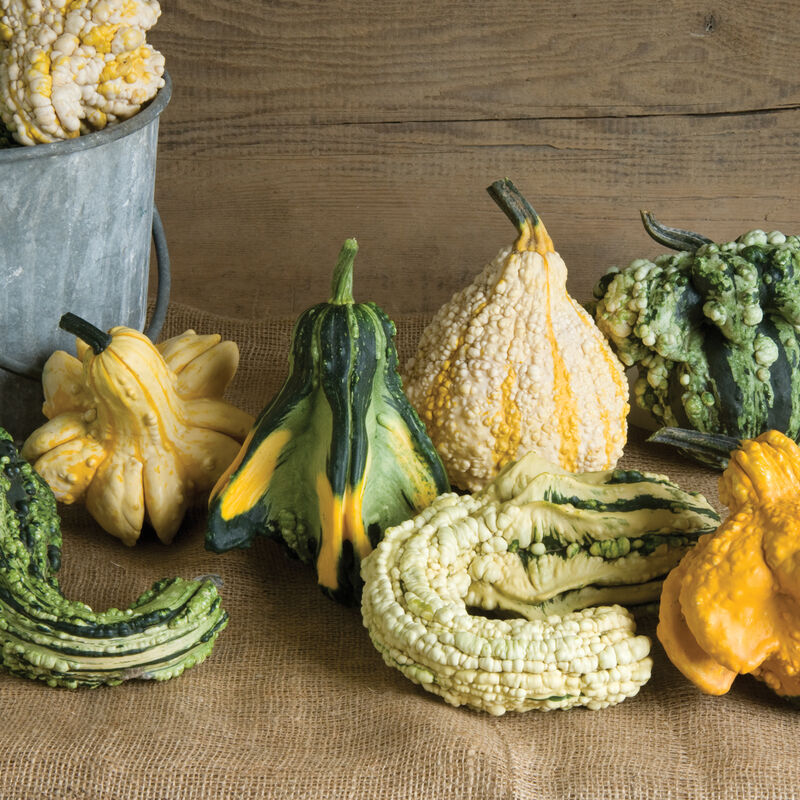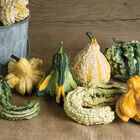Gremlins Gourd Seed
Gremlins Gourd Seed
Large, colorful, warted collection.
Gremlins are bright, bold, and crazy with warts. Small to medium-size (5–7"+) gourds with various solid and speckled vibrant colors, in a multitude of shapes: stars, wings, acorns, mushrooms, necks, and more. A complete stunner in our trials. Avg. weight: 1–1 1/4 lb.Specs:
- This product does not ship to the following countries: Australia, Japan, Republic of Korea, New Zealand, Taiwan.
SCIENTIFIC NAME:
Cucurbita spp.CULTURE:
Full sun and fertile, well-drained soil is best, with a pH of 5.8-6.8. Plastic mulch and fabric row covers (AG-19 grade) can aid plant establishment and exclude insect pests during the seedling stage. Row covers should be removed when plants begin to flower. Poor fruit development may indicate insufficient pollination. Gourd can also be grown on sturdy trellises.TRANSPLANTING:
Sow 2-3 seeds per 2" container or plug flat about 3 weeks prior to transplanting date. If growing a mixed variety, sort seeds into groups by shape and size prior to sowing. Sow similar seeds in each cell or container to increase likelihood of obtaining full mix of plants and fruit types. Thin to 1 plant per container/cell with scissors. Harden off plants 4-7 days prior to transplanting. After danger of frost has passed, transplant out according to spacing recommendations for each variety. Between row spacing is generally 6-12'; in-row spacing depends on fruit size and is generally as follows: small, 18-24"; medium, 24-36"; large, 36-48". Handle seedlings carefully; minimal root disturbance is best.DIRECT SEEDING:
Sow in late spring, when soil temperature is at least 70°F/21°C, and frost danger has passed. If sowing a mixed variety, sort seeds prior to sowing as described above. Sow 2 seeds at each spacing interval, ½-1" deep; thin to 1 plant per spacing interval after seedlings are established.DISEASES:
Common diseases include powdery mildew, downy mildew, bacterial wilt, viruses, and phytopthora blight. Avoid problems through adequate soil drainage, good air flow, insect pest control, and crop rotation. If necessary, check with your local Cooperative Extension Service agent for specific fungicide recommendations.PESTS:
Common pests include cucumber beetles, squash bugs, and vine borers. Protect young plants with floating row covers. Squash bugs eggs found on the undersides on leaves may be crushed by hand. For vine borers, cut out of vines and hill soil over wound. Keep field borders mowed and remove plant refuse in fall; spring plow to bury pupae. Pyrethrin sprays may offer some control.HARVEST:
For C. pepo types, harvest when color fully developed and stems are dry, but before hard frost. Cure out of direct sunlight at 80-85°F/27-29°C with good air ventilation for 5-7 days. Wash fruits, dry, seal with furniture polish; use for displays. For L. siceraria types, harvest when stems dry and color fades; keep on vine as long as possible, frost will not harm fruits. Store in dry, well-ventilated area until completely dried (3-6 months) prior to crafting use.SEED SPECS:
SEEDS/LB.: Small-fruited: avg. 9,900. Large-fruited: avg. 2,600.PACKET:
30 seeds.Johnny's is committed to your success, every step of the way.
We want you, our customer, to be 100% satisfied with all of our seeds, tools, and supplies.
If anything you purchase from us proves unsatisfactory, we will either replace the item or refund the purchase price.



